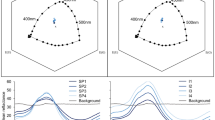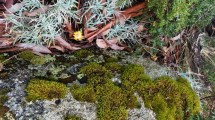Abstract
Spatial vision is an important cue for how honeybees (Apis mellifera) find flowers, and previous work has suggested that spatial learning in free-flying bees is exclusively mediated by achromatic input to the green photoreceptor channel. However, some data suggested that bees may be able to use alternative channels for shape processing, and recent work shows conditioning type and training length can significantly influence bee learning and cue use. We thus tested the honeybees’ ability to discriminate between two closed shapes considering either absolute or differential conditioning, and using eight stimuli differing in their spectral characteristics. Consistent with previous work, green contrast enabled reliable shape learning for both types of conditioning, but surprisingly, we found that bees trained with appetitive-aversive differential conditioning could additionally use colour and/or UV contrast to enable shape discrimination. Interestingly, we found that a high blue contrast initially interferes with bee shape learning, probably due to the bees innate preference for blue colours, but with increasing experience bees can learn a variety of spectral and/or colour cues to facilitate spatial learning. Thus, the relationship between bee pollinators and the spatial and spectral cues that they use to find rewarding flowers appears to be a more rich visual environment than previously thought.






Similar content being viewed by others
References
Avargues-Weber A, de Brito Sanchez MG, Giurfa M, Dyer AG (2010a) Aversive reinforcement improves visual discrimination learning in free-flying honeybees. PLoS ONE 5:e15370
Avargues-Weber A, Portelli G, Benard J, Dyer AG, Giurfa M (2010b) Configural processing enables discrimination and categorization of face-like stimuli in honeybees. J Exp Biol 213:593–601
Avargues-Weber A, Deisig N, Giurfa M (2011) Visual cognition in social insects. Ann Rev Entomol 56:423–443
Backhaus W (1991) Color opponent coding in the visual system of the honeybee. Vis Res 31:1381–1397
Bates D, Maechler M, Bolker B (2011) lme4: Linear mixed-effect models using S4 classes. R package version 0.999375-42. http://CRAN.R-project.org/package=lme4
Baumgärtner H (1928) Der Formensinn und die Sehschärfe der Bienen. Z Vergl Physiol 7:56–143
Briscoe AD, Chittka L (2001) The evolution of color vision in insects. Annu Rev Entomol 46:471–510
Burns JG, Dyer AG (2008) Diversity of speed-accuracy strategies benefits social insects. Curr Biol 18:R953–R954
Campan R, Lehrer M (2002) Discrimination of closed shapes by two species of bee, Apis mellifera and Megachile rotundata. J Exp Biol 205:559–572
Chittka L (1992) The colour hexagon: a chromaticity diagram based on photoreceptor excitations as a gerneralized representation of colour opponency. J Comp Physiol A 170:533–543
Daumer K (1956) Reizmetrische Untersuchungen des Farbensehens der Bienen. Z Vergl Physiol 38:413–478
Dyer AG (2012) The mysterious cognitive abilities of bees: why models of visual processing need to consider experience and individual differences in animal performance. J Exp Biol 215:387–395
Dyer AG, Chittka L (2004a) Biological significance of distinguishing between similar colours in spectrally variable illumination: bumbleebees (Bombus terrestris) as a case study. J Comp Physiol A 190:105–114
Dyer AG, Chittka L (2004b) Fine colour discrimination requires differential conditioning in bumblebees. Naturwissenschaften 91:224–227
Dyer AG, Griffiths DW (2012) Seeing near and seeing far; behavioural evidence for dual mechanisms of pattern vision in the honeybee (Apis mellifera). J Exp Biol 215:397–404
Dyer AG, Neumeyer C (2005) Simultaneous and successive colour discrimination in the honeybee (Apis mellifera). J Comp Physiol A 191:547–557
Dyer AG, Vuong QC (2008) Insect brains use image interpolation mechanisms to recognise rotated objects. PLoS ONE 3:e4086
Dyer AG, Neumeyer C, Chittka L (2005) Honeybee (Apis mellifera) vision can discriminate between and recognise images of human faces. J Exp Biol 208:4709–4714
Dyer AG, Whitney H, Arnold S, Glover B, Chittka L (2007) Mutations perturbing petal cell shape and anthocyanin synthesis influence bumblebee perception of Antirrhinum majus flower colour. Arthropod-Plant Interact 1:45–55
Dyer AG, Rosa MGP, Reser DH (2008a) Honeybees can recognise images of complex natural scenes for use as potential landmarks. J Exp Biol 211:1180–1186
Dyer AG, Spaethe J, Prack S (2008b) Comparative psychophysics of bumblebee and honeybee colour discrimination and object detection. J Comp Physiol A 194:617–627
Dyer AG, Paulk AC, Reser DH (2011) Colour processing in complex environments: insights from the visual system of bees. Proc R Soc B 278:952–959
Fox J (2003) Effect displays in R for generalised linear models. J Stat Soft 8:1–27
Fox J, Weisberg S (2011) An R Companion to applied regression. Sage, Thousand Oaks
Giger AD, Srinivasan MV (1996) Pattern recognition in hoenybees: chromatic properties of orientation analysis. J Comp Physiol A 178:763–769
Giurfa M (2004) Conditioning procedure and color discrimination in the honeybee Apis mellifera. Naturwissenschaften 91:228–231
Giurfa M, Backhaus W, Menzel R (1995a) Color and angular orientation in the discrimination of bilateral symmetric patterns in the honeybee. Naturwissenschaften 82:198–201
Giurfa M, Núñez J, Chittka L, Menzel R (1995b) Colour preference of flower-naive honeybees. J Comp Physiol A 177:247–259
Giurfa M, Eichmann B, Menzel R (1996a) Symmetry perception in an insect. Nature 382:458–461
Giurfa M, Vorobyev M, Kevan P, Menzel R (1996b) Detection of coloured stimuli by honeybees: minimum visual angles and receptor specific contrasts. J Comp Physiol A 178:699–709
Giurfa M, Vorobyev M, Brandt R, Posner B, Menzel R (1997) Discrimination of coloured stimuli by honeybees: alternative use of achromatic and chromatic signals. J Comp Physiol A 180:235–243
Giurfa M, Hammer M, Stach S, Stollhoff N, Müller-Deisig N, Mizyrycki C (1999) Pattern learning by honeybees: conditioning procedure and recognition strategy. Anim Behav 57:315–324
Gould JL, Gould CG (1988) The honey bee. Scientific American Library, New York
Goulson D, Cruise JL, Sparrow KR, Harris AJ, Park KJ, Tinsley MC, Gilburn AS (2007) Choosing rewarding flowers; perceptual limitations and innate preference influence decision making in bumblebees and honeybees. Behav Ecol Sociobiol 61:1523–1529
Gumbert A (2000) Color choice by bumble bees (Bombus terrestris): innate preferences and generalization after learning. Behav Ecol Sociobiol 48:36–43
Hempel de Ibarra N, Giurfa M (2003) Discrimination of closed coloured shapes by honeybees requires only contrast to the long wavelength receptor type. Anim Behav 66:903–910
Hempel de Ibarra N, Giurfa M, Vorobyev M (2001) Detection of coloured patterns by honeybees through chromatic and achromatic cues. J Comp Physiol A 187:215–224
Hertz M (1929) Die Organisation des optischen Feldes bei der Biene. I. Z Vergl Physiol 8:693–748
Hill PSM, Wells PH, Wells H (1997) Spontaneous flower constancy and learning in honey bees as a function of colour. Anim Behav 54:615–627
Horridge A (2009) Generalization in visual recognition by the honeybee (Apis mellifera). A review and explanation. J Insect Physiol 55:499–511
Kien J, Menzel R (1977) Chromatic properties of interneurons in the optic lobes of the bee II. Narrow band and colour opponent neurons. J Comp Physiol A 113:35–53
Kulahci IG, Dornhaus A, Papaj DR (2008) Multimodal signals enhance decision making in foraging bumble-bees. Proc R Soc B 275:797–802
Lehrer M (1999) Dorsoventral asymmetry of colour discrimination in bees. J Comp Physiol A 184:195–206
Lehrer M, Campan R (2005) Generalization of convex shapes by bees: what are shapes made of? J Exp Biol 208:3233–3247
Lunau K (1990) Colour saturation triggers innate reactions to flower signals: flower dummy experiments with bumblebees. J Comp Physiol A 166:827–834
Lunau K, Wacht S, Chittka L (1996) Colour choices of naive bumble bees and their implications for colour perception. J Comp Physiol A 178:477–489
Mazochin-Porshnyakov GA (1969) Die Fähigkeit der Bienen, visuelle Reize zu generalisieren. Z Vergl Physiol 65:15–28
Menzel R (1967) Untersuchungen zum Erlernen von Spektralfarben durch die Honigbiene (Apis mellifica). Z vergl Physiol 56:22–62
Menzel R, Giurfa M (2006) Dimensions of cognition in an insect, the honeybee. Behav Cogn Neurosci Rev 5:24–40
Møller AP (1995) Bumblebee preference for symmetrical flowers. P Natl Acad Sci USA 92:2288–2292
Peitsch D, Fietz A, Hertel H, Souza J, Ventura DF, Menzel R (1992) The spectral input systems of hymenopteran insects and their receptor-based colour vision. J Comp Physiol A 170:23–40
R Development Core Team (2011) R: A language and environment for statistical computing. R Foundation for Statistical Computing Vienna, Austria. http://www.R-project.org/
Reinhard J, Srinivasan MV, Guez D, Zhang SW (2004) Floral scents induce recall of navigational and visual memories in honeybees. J Exp Biol 207:4371–4381
Reser DH, Wijesekara Witharanage R, Rosa MGP, Dyer AG (2012) Honeybees (Apis mellifera) learn color discriminations via differential conditioning independent of long wavelength (green) photoreceptor modulation. PLoS ONE 7:e48577
Ronacher B (1992) Influence of unrewarded stimuli on the classification of visual patterns by honey bees. Ethology 92:205–216
Ronacher B, Duft U (1996) An image-matching mechanism describes a generalization task in honeybees. J Comp Physiol A 178:803–812
Spaethe J, Tautz J, Chittka L (2001) Visual constraints in foraging bumblebees: flower size and color affect search time and flight behavior. P Natl Acad Sci USA 98:3898–3903
Srinivasan MV, Lehrer M (1988) Spatial acuity of honeybee vision and its spectral properties. J Comp Physiol A 162:159–172
Stach S, Giurfa M (2005) The influence of training length on generalization of visual feature assemblies in honeybees. Behav Brain Res 161:8–17
Stach S, Benard J, Giurfa M (2004) Local-feature assembling in visual pattern recognition and generalization in honeybees. Nature 429:758–761
Streinzer M, Paulus HF, Spaethe J (2009) Floral colour signal increases short-range detectability of a sexually deceptive orchid to its bee pollinator. J Exp Biol 212:1365–1370
von Frisch K (1914) Der Farbensinn und Formensinn der Biene. Z Jb Abt Allg Zool Physiol 35:1–188
von Frisch K (1967) The dance language and orientation of bees. Harvard University Press, Harvard
von Helversen O (1972) Zur spektralen Unterschiedsempfindlichkeit der Honigbiene. J Comp Physiol A 80:439–472
Wignall AE, Heiling AM, Cheng K, Herberstein ME (2006) Flower symmetry preferences in honeybees and their crab spider predators. Ethology 112:510–518
Wu W, Moreno A, Tangen J, Reinhard J (2013) Honeybees can discriminate between Monet and Picasso paintings. J Comp Physiol A 199:45–55
Yang EC, Lin HC, Hung YS (2004) Patterns of chromatic information processing in the lobula of the honeybee, Apis mellifera L. J Insect Physiol 50:913–925
Zhang SW, Srinivasan MV, Collett T (1995) Convergent processing in honeybee vision: multiple channels for the recognition of shape. P Natl Acad Sci USA 92:3029–3031
Zhang S, Srinivasan MV, Zhu H, Wong J (2004) Grouping of visual objects by honeybees. J Exp Biol 207:3289–3298
Acknowledgments
We would like to thank Martin Streinzer for performing the colour measurements and the two anonymous reviewers for their constructive comments of the manuscript. L.M. was recipient of a DOC-fFORTE fellowship of the Austrian Academy of Science at the Department of Integrative Zoology, University of Vienna. A.G.D. was supported by Australian Research Council DP0878968/DP0987989/DP130100015 and the Alexander von Humboldt Foundation.
Author information
Authors and Affiliations
Corresponding author
Electronic supplementary material
Below is the link to the electronic supplementary material.
Rights and permissions
About this article
Cite this article
Morawetz, L., Svoboda, A., Spaethe, J. et al. Blue colour preference in honeybees distracts visual attention for learning closed shapes. J Comp Physiol A 199, 817–827 (2013). https://doi.org/10.1007/s00359-013-0843-5
Received:
Revised:
Accepted:
Published:
Issue Date:
DOI: https://doi.org/10.1007/s00359-013-0843-5




